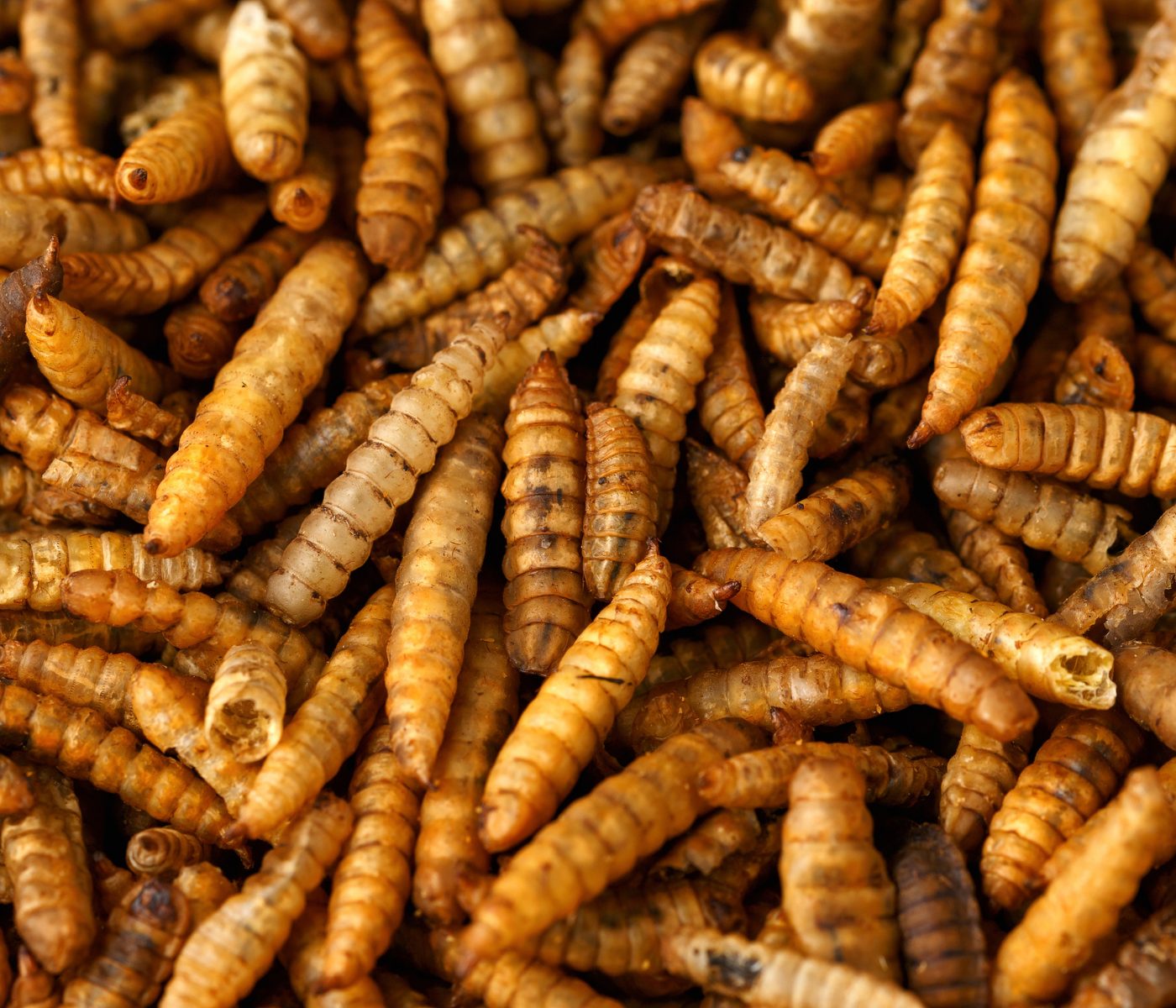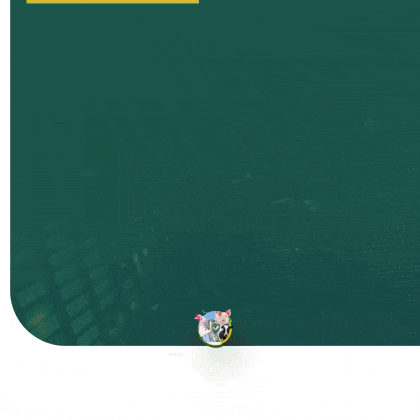Insects represent a promising alternative for swine nutrition.
The term entomophagy derives from the Greek éntomon, ‘insect’, and phagein, ‘to eat’. It describes a type of feeding behavior in which insects are considered as food sources for human consumption or as animal feed.
Insects as part of a circular economy
Global population growth and rising demands for animal derived foods are major drivers for finding alternative and sustainable feed sources. As these are necessary for maintaining livestock production to meet this growing demands.
- In addition, the increased need for raw materials puts additional pressure on limited natural resources such as land, water and energy. This trend will require the adoption of specific policies to address sustainability issues.
![]()
| Insects possess peculiar physiological characteristics that allow them to harness protein and energy from the diet more effectively than conventional livestock species. |
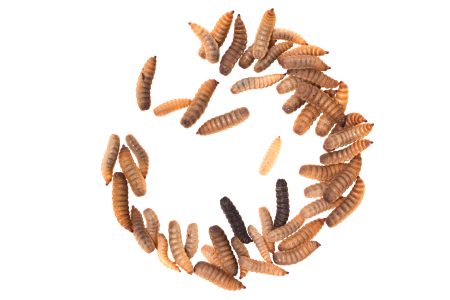
Insects are poikilothermic animals (i.e. their body temperature varies considerably). Therefore, their metabolism does not require energy to maintain a constant internal temperature, unlike what happens with homeothermic animals (mammals and avian species). 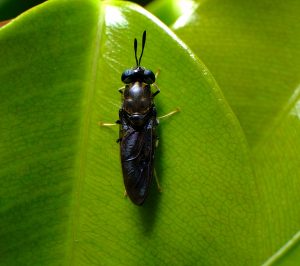
![]() As a result, insects can convert nutrients from the diet into body proteins quite favorably.
As a result, insects can convert nutrients from the diet into body proteins quite favorably.
![]() Feed conversion rates (the amount of feed needed to produce a weight gain of 1 kg) vary greatly depending on the animal species as well as on production practices.
Feed conversion rates (the amount of feed needed to produce a weight gain of 1 kg) vary greatly depending on the animal species as well as on production practices.
From an ecological standpoint, animal production represents a type of predatory relationship, where members of one species consume individuals from another species. From an anthropological point of view, it is a widespread practice amongst various populations and species within the planet aimed at satisfying nutritional needs.
![]() The practice of eating insects is cited throughout religious literature. Including Christian, Jewish, and Islamic confessions: “John was clothed in camel hair and with a belt of skins around his back, and ate locusts and wild honey (Mark I:6).”
The practice of eating insects is cited throughout religious literature. Including Christian, Jewish, and Islamic confessions: “John was clothed in camel hair and with a belt of skins around his back, and ate locusts and wild honey (Mark I:6).”
Typically, in U.S. production systems; 1 kg of live animal weight requires the following amount of feed: 2.5 kg for chicken, 5 kg for pork, and 10 kg for beef.
![]() Insects require much less food. For example, the production of 1 kg of live weight for crickets, only requires 1.7 kg of feed. When these figures are adjusted to edible weight (normally the whole animal cannot be eaten), the advantages of insect consumption are even greater (Van Huis, 2013).
Insects require much less food. For example, the production of 1 kg of live weight for crickets, only requires 1.7 kg of feed. When these figures are adjusted to edible weight (normally the whole animal cannot be eaten), the advantages of insect consumption are even greater (Van Huis, 2013).
Insects have gained significant attention within a Circular Economy (CE) approach. The circular economy concept can be defined as:
![]() A regenerative system that minimizes the entry of resources as well as reducing the generation of waste, emissions,and energy waste.
A regenerative system that minimizes the entry of resources as well as reducing the generation of waste, emissions,and energy waste.
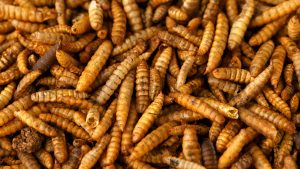
In practice, this means reducing waste to a minimum. Beside possessing a better ability to convert organic matter into protein compared with other species, insects require significantly less: rearing space, water, and often less energy than conventional livestock (Figure 1, Dobermann et al., 2017).
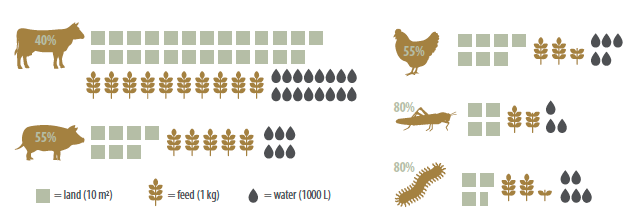
Figure 1. Amount of land, feed and water needed to produce 1 kg of live animal weight and percentage of animal that is edible (adapted from Dobermann et al., 2017).
Due to their nutrient profile, they can contribute to more balanced diets for humans and animals. Acting as substitutes for ecologically critical ingredients, such as:
![]() Fish meal
Fish meal
![]() Soybeans
Soybeans
| Insects are also capable of effectively converting organic, often unused and available waste into body mass (Derler et al., 2021). |
EU legislation on the use of insects in feed formulation
Insect producers are responsible for ensuring the safety of products placed on the market in accordance with the European “General Food Law” (EC Regulation 178/2002) and the “hygiene package” (e.g. EC Regulation 852/2004 and EC Regulation 183/2005).
![]() Insects and their derived products, excluding live insects, intended for animal feed are considered animal by-products. This qualification entails a series of obligations for producers which are defined in Regulation EC 1069/2009 and its EU Implementing Regulation 142/2011.
Insects and their derived products, excluding live insects, intended for animal feed are considered animal by-products. This qualification entails a series of obligations for producers which are defined in Regulation EC 1069/2009 and its EU Implementing Regulation 142/2011.
Following the publication of EFSA’s 2015 opinion on the “Risk profile related to the production and consumption of insects as food and feed,” EU Regulation 2017/893 authorised processed animal proteins from farmed insects for aquaculture species for the first time. The authorized sources of insect protein were:
![]() Black soldier fly (Hermetia illucens) and common housefly (Musca domestica);
Black soldier fly (Hermetia illucens) and common housefly (Musca domestica);
![]() Yellow mealworm (Tenebrio molitor) and lesser mealworm (Alphitobius diaperinus);
Yellow mealworm (Tenebrio molitor) and lesser mealworm (Alphitobius diaperinus);
![]() House cricket (Acheta domesticus), ringed cricket (Gryllodes sigillatus) and field cricket
House cricket (Acheta domesticus), ringed cricket (Gryllodes sigillatus) and field cricket
Following the changes introduced in EC Regulation 999/2001 by EU Regulation 2021/1372, processed animal proteins derived from insects are now allowed for use in pig or poultry feed, together with pet and fur feed (Ipiff, 2021).
Insects in pig diets
Most studies conducted on the digestibility of proteins and amino acids, as well as those carried out to evaluate the zootechnical performance of diets containing insects, yield varying. Depending on: insect species being evaluated, processing methods, dietary formulation and the experimental design used.

![]()
However, overall, the results available to date indicate that insect-based meals have good potential as protein sources for pig nutrition.
As recently noted by Veldkamp and Vernooij (2021), the protein content of (Tenebrio molitor; TM), housefly (Musca Domestica, MD) and black soldier fly (BSF) is comparable to soybean meal, but lower than that of fishmeal.
|
The fat content of these insect species is higher than that of soybean meal and fishmeal, while their amino acid profile is similar to that of soybean meal and fishmeal (Table 1, Veldkamp and Vernooij 2021). |
Table 1. Chemical composition of products from black soldier fly prepupae, housefly larvae meal, mealworm larvae, soybean meal and fishmeal (modified from Veldkamp and Vernooij, 2021).
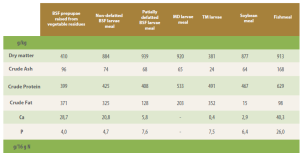
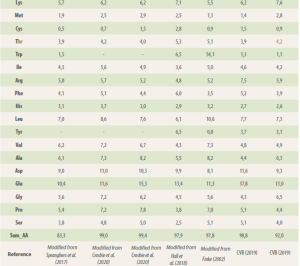
| AA = amino acid; Ala = alanine; Arg = arginine; Asp = aspartate; MSN = black soldier fly (Hermetia illucens); Ca = calcium; Cys = cysteine; Glu = glutamate; Gly = glycine; MD = housefly (Musca domestica); His = histidine; Ile = isoleucine; Leu = leucine; Lys = lysine; Met = methionine; N = nitrogen; P = phosphorus; Phe = phenylalanine; Pro = proline; Ser = serine; Thr = threonine; TM = Tenebrio molitor; Trp = tryptophan; Tyr = tyrosine; Val = valine |
The standardized ileal digestibility of crude protein and amino acids from whole BSF larval meal, partially defatted BSF larval meal, and MD larval meal in growing pigs is comparable to the digestibility of amino acids from soybean meal and fishmeal.
![]() The amino acid digestibility of MD larval meal was higher to that of BSF larval meal.
The amino acid digestibility of MD larval meal was higher to that of BSF larval meal.
Regarding growth parameters, the inclusion of 3.5% BSF larvae instead of fishmeal in piglet diets for creep feeding did not modify weight gain. As for weaned piglets, the use of air-dried TM larvae at 0, 1.5, 3.0, 4.5 and 6.0% at the expense of soybean meal and soybean oil resulted in a linear improvement in growth parameters for animals from 28 to 63 days of age.
The inclusion of 5-10% MT in diets for weaned piglets aged 35 to 63 days as a substitute of soybean meal did not affect yield parameters. The ADG was only lower for pigs fed diets with 10% TM compared to those which were fed control diets with the addition of TM at an inclusion level of 5%.
◊ Non-defatted BSF used at 0, 4 and 8% and defatted BSF used at 5.4% in substitution of roasted soybeans did not modify weaning growth parameters (21-36 day old piglets).
◊ Partially defatted BSF, including 0, 5 and 10% replacing soybean meal, resulted in higher feed intake during the second phase of the experiment (piglets 21-61 days old).
◊ In growing pigs weighing 11-29 kg, sun-dried MD larvae used at 0% and 10% to replace fishmeal resulted in higher ADG and improved CI. BSF larval meal used at 0, 9, 12, 14.5 and 18.5% to replace fishmeal did not affect growth parameters in 18-53 kg pigs.
◊Dried BSF powder larvae, used at 0, 4 and 8% to replace soybean meal, resulted in better performance when used at 4% in feeds for fattening pigs (76-115 kg live weight) compared to the inclusion of 0 and 8% (Table 2, Veldkamp and Vernooij, 2021).
Table 2. Growth of pigs fed insect-based products (taken from Veldkamp and Vernooij, 2021).
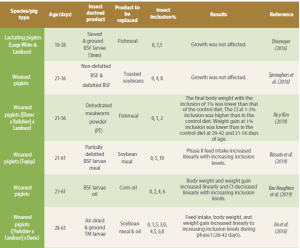
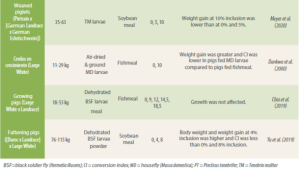
| In regards to carcass and meat quality the few available and current studies which have been published, don’t seem to highlight any negative effect regarding insect inclusion in pig diets. |
![]() Similar to the aforementioned lack of information regarding carcass and meat quality; there are still very few studies assessing the health effects associated with insect inclusion in animal diets.
Similar to the aforementioned lack of information regarding carcass and meat quality; there are still very few studies assessing the health effects associated with insect inclusion in animal diets.
However, current available results, suggest that there could be a potential improvement of intestinal microbial populations, induced by bioactive substances (e.g. antimicrobial peptides, lauric acid) contained in insect bodies.
Another interesting aspect related to the use of insects, is their role as environmental enrichment elements. Recent research carried out at Wageningen University(Ipema et al., 2021) shows that live BSF larvae significantly attract weaned piglets. Exerting beneficial effects on their behavior, and favoring overall animal welfare.
Future needs and prospects
The main challenge facing the insect protein industries is that of scalability. Considering the fact that the current marketing price of insect meal is not competitive enough yet.
⇒Significantly high quality levels in these products must be maintained in order to meet market expectations, and become competitive.
More cost-benefit analyses are also needed in order to evaluate how these alternative ingredients effectively influence overall production costs.
Under such context, the functional value of insects in terms of improving pig health deserves special attention. As it could further increase the competitiveness and economic outlook of these protein sources compared to conventional ones.
![]() Considering insects as a type of mini-livestock species, their welfare should be safeguarded during all stages of production and slaughter,just like any other species.
Considering insects as a type of mini-livestock species, their welfare should be safeguarded during all stages of production and slaughter,just like any other species.
![]() In regards to consumer acceptance, insect presence in different feedstuffs,does not seem to represent an obstacle. However, this may change according to individual characteristics and differences in specific food-producing animals.
In regards to consumer acceptance, insect presence in different feedstuffs,does not seem to represent an obstacle. However, this may change according to individual characteristics and differences in specific food-producing animals.
![]() Therefore, it is necessary to carry out studies to evaluate acceptance levels for of high-quality products. Including meat products with protected designation of origin (PDO),obtained from animals that have been fed with non-conventional ingredients. This is especially true for hams(Spain, Italy and France are some of the major producers of these types of products.)
Therefore, it is necessary to carry out studies to evaluate acceptance levels for of high-quality products. Including meat products with protected designation of origin (PDO),obtained from animals that have been fed with non-conventional ingredients. This is especially true for hams(Spain, Italy and France are some of the major producers of these types of products.)
![]() Finally, further studies should be conducted using the LCA (Life Cycle Assessment) method to further investigate the potential of using insects as an environmental friendly option.
Finally, further studies should be conducted using the LCA (Life Cycle Assessment) method to further investigate the potential of using insects as an environmental friendly option.
| The Department of Veterinary Medicine at the University of Bologna (Italy) in collaboration with an external company, is investigating the “welfare” of BSF larvae according to their breeding conditions. There is also a project which aims to investigate the effects on pig genotypes as and their suitable age for PDO ham production with dietary BSF larvae inclusion. |

